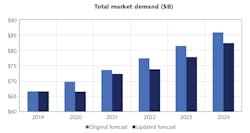Biophotonics instrumentation markets and the impact of COVID-19
The Lasers & Photonics Marketplace Seminar provides insights to the markets for lasers and photonics. While these markets had been reviewed from various angles during the seminar, Bruce Carlson adds yet another important perspective. He reports on the $66 billion market for life science & analytical instrumentation, with insights based on the publications he oversees.
Their methods are based on counting and predicting the sale of instruments, related consumables, or service packages. The instruments are devices that make measurements in applications from research to quality control. It also includes associated technologies for sample preparation and other lab equipment. The definition of the market excludes online process instrumentation and diagnostics. It includes systems, aftermarket consumables, and service revenues.
Carlson distinguishes 83 technologies grouped into 10 categories of related instruments. Most of them use photonics components. He selected four of these categories with a strong relation to photonics for a detailed presentation:
- Life science & analytical instrumentation
- Atomic spectroscopy
- Molecular spectroscopy
- Surface science
Impact of COVID-19 on markets for life science & analytical instrumentation
Most market forecasts for 2020 had to be revised following the outbreak of the pandemic, and the life science & analytical instrumentation markets were no exception (see figure). But it came as a surprise to most seminar participants that these markets were shrinking: the forecast for 2020 was corrected from a 5% growth to a -1% decline. And the markets won’t meet the older forecasts for the foreseeable future, even with a 9.4% rebound in 2021.
Most technologies saw a drop in market demand in 2020, as Carlson explained. Most were related to the closure of labs and the related hold on investment. The few areas with a COVID-19-related boom, such as polymerase chain reaction (PCR) and nucleic acid preparation technology, were not significant enough to compensate for this effect.
Sales and forecast in selected markets
As promised, Carlson shared insights to the market of atomic spectroscopy. Most of these systems have optical systems and spectrometers operating in the visible or visible-to-UV range. Obviously, the x-ray technologies are focused on that part of the electromagnetic spectrum. A few systems involve lasers, mostly to evaporate samples. After all, Carlson expects sales growth between 5% and 10% in all areas of atomic spectroscopy.
For molecular spectroscopy, he expects lower growth of 3% to 5%, with significantly higher unit sales. While a few thousand instruments are sold in atomic spectroscopy, unit sales for molecular spectroscopy typically rise to tens of thousands. For UV/visible spectrometers, from simple photometers to high-end spectrometers, he expects as many as 300,000 instruments sold.
The highest growth among molecular spectrometers is expected for Raman technology with 6.1% towards 6700 units sold. In the subsequent Q&A session, Carlson’s colleague Mike Tice added that handheld Raman is particularly rising. For a long time, “handheld” meant to use two hands to hold it, but now it’s really getting into something much more comfortable to hold. These systems are being used in pharmaceutical companies on the loading dock, for example, to verify a material’s identity.
A niche application Carlson mentioned is terahertz spectroscopy. The technology promises to get past the barriers that are invisible, including opaque polymers and ceramics, to get behind and to look at certain tablets, and even to look at the molecular interactions behind the surface accessible with terahertz. Terahertz radiation is nondestructive, it does not warm, and it is non-ionizing.
Terahertz systems have seen a lot of technological progress. Initial systems were expensive, some just hand-made by individual principal investigators. Now, there are more commercial suppliers of a complete system that people could use for research, and this brought costs down. Carlson thinks it will have more and more uses in life sciences, where you need to study tissue samples and pharmaceutical or biological compounds. Cheaper photonics for terahertz systems are something that could help promote these products, he said.
The sector of surface science is essentially microscopy, as Carlson explained. Traditional optical microscopes are going to be the largest portion of this. They are very common instruments; 290,000 unit sales are projected for 2021 at a growth rate of 5.7%. Some systems use fluorescence effects, which assumes a laser as the light source. An increase of almost 16% is expected for superresolution microscopy, at low unit numbers of about 200.
Not surprisingly, the biggest growth is expected for life science systems. This field encloses machines for DNA sequencing and PCR, flow cytometry, microarrays, high content analysis, surface plasmon resonance (SPR) and label-free detection, and cell counters. Some areas, such as DNA sequencing, received an additional stimulus during the pandemic, leading to an expected growth of 30%.
In a brief summary, Carlson noted that there's fairly high growth in most cases, higher than the overall market for instrumentation in those areas that use lasers or photonics.
CONTINUE READING >>>
About the Author
Andreas Thoss
Contributing Editor, Germany
Andreas Thoss is the Managing Director of THOSS Media (Berlin) and has many years of experience in photonics-related research, publishing, marketing, and public relations. He worked with John Wiley & Sons until 2010, when he founded THOSS Media. In 2012, he founded the scientific journal Advanced Optical Technologies. His university research focused on ultrashort and ultra-intense laser pulses, and he holds several patents.

